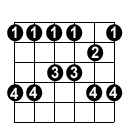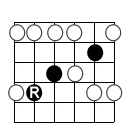CAGED HOME | Getting Started | Chord Shapes | Scale Shapes | Arpeggio Shapes |Minor Chord Shapes | Minor Scale Shapes | Minor Arpeggio Shapes | More CAGED
There are five scale shapes in CAGED-just like there were only five chord shapes. With each of the five basic chord shapes you’ll find a “built-in” scale pattern that surrounds and encompasses on of the five basic chord shapes. The most commonly used scales by guitarists are called pentatonic scales. The word pentatonic gets it’s name from the Greek word “penta” which means 5 and tonic which stands for tone. That’s what pentatonic scales are: 5 tone scales. The reason they are so commonly used is because
their patterns are extremely well suited to the guitar’s fretboard and allow a lot of musical freedom when you are playing them.
There are only 5 basic pentatonic patterns. They are the C, A, G, E, and D. They are similar to the 5 basic chord patterns, because they can be closely associated with their chord counterparts. These patterns interlock with each other, meaning each pattern has notes that overlap with patterns adjacent to it.
These are the fundamental building blocks of your soloing and you will use the for many years to come. These patterns are the same thing as the pentatonic major.
Memorize each pattern. You should be able to identify them by name and you should know exactly which note is their root note (marked by an “R” in the pictures on the right).
Remember that these are in the close position. You can play them in different key signatures by just moving them up and down the fret board. Do you want to see them in the open position? Check this out: CAGED Open Position Scales.
The pictures on the left are the patterns with their suggested fingerings. The pictures on the right are the patterns with their CAGED chord counterpart they are associated with highlighted.
C Scale Pattern
Here is the scale pattern played in the key of C#/Db, because the root
note appears on the 4th fret of the A string.
As with all patterns it can be transposed to any key. The pattern remains
the same. Here is the same pattern in the key of F, because the root
note
appears on the 8th fret of the A string which is an F note.
Notice that it looks the same when played. The only difference is that
the pattern is being played higher up on the fretboard:
A Scale Pattern
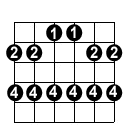

Below is the A scale pattern in the key of C#/Db, because the root note
appears on the 4th fret of the A string.

G Scale Pattern
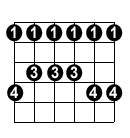
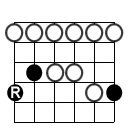
Below is the G scale pattern in the key of C#/Db, because the root note
appears on the 9th fret of the low E string.

E Scale Pattern

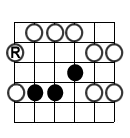
Below is the E scale pattern in the key of D, because the root note appears
on the 10th fret of the low E string.

D Scale Pattern

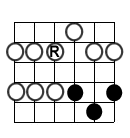
Below is the D scale pattern in the key of B, because the root note appears
on the 9th fret of the D string which is a B note.

Check out these cool sequence charts that show you how the five scale patterns transverse the entire fret board in different key signature:
Memorize and practice these scale shapes in relation to the chords they are built upon until it’s ingrained into your brain.
